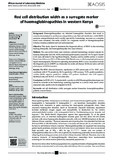Red cell distribution width as a surrogate marker of haemoglobinopathies in western Kenya
Abstract
distribution width (RDW) measures anisopoikiloytosis and is readily reported by haematology analysers as a complete blood count parameter. The utility of RDW as a diagnostic marker of haemoglobinopathies in Kenya remains undetermined and undocumented.
Objective: This study aimed to determine the diagnostic efficacy of RDW in discriminating haemoglobinopathy and haemoglobinopathy-free cases in Kenya.
Methods: The case-control study used randomly selected haematology analyser outputs for haemoglobinopathy-free (241, 49.4%) and haemoglobinopathy cases (247, 50.1%) aged 1 month to 66 years old tested in the Aga Khan Hospital, Kisumu, and its satellite centres in western Kenya from 01 January 2015 to 31 December 2020. Results were verified using high performance liquid chromatography. The receiver operating characteristic (ROC) curve was used to evaluate the diagnostic power of RDW as a biomarker for sickle cell disease (SCD) and sickle cell trait phenotypes and β-thalassaemia.
Results: The RDW showed diagnostic significance in SCD phenotypes at 21.1 ROC curve coordinate with 67.7% sensitivity, 90.0% specificity, 0.789 accuracy, 70.5% positive predictive validity, 88.8% negative predictive validity, 6.77 positive likelihood ratio, 0.36 negative likelihood ratio and 18.94 (11.4–31.4) odds ratio.
Conclusion: An RDW of 21.1% is potentially a predictor of SCD haemoglobin phenotypes and should be included in the haematology screening algorithm as a critical value, above which suspected cases qualify to be investigated for SCD.
URI
https://doi.org/10.4102/ajlm.v11i1.1644https://ajlmonline.org/index.php/ajlm/article/view/1644
http://ir-library.mmust.ac.ke:8080/xmlui/handle/123456789/2048
Collections
- Gold Collection [969]

